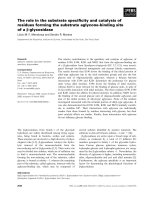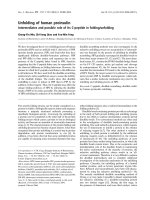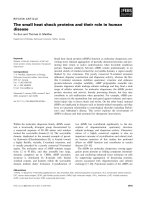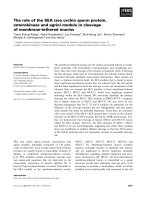Báo cáo khoa học: "Semantic Role Labeling: Past, Present and Future" ppt
Bạn đang xem bản rút gọn của tài liệu. Xem và tải ngay bản đầy đủ của tài liệu tại đây (60.95 KB, 1 trang )
Tutorial Abstracts of ACL-IJCNLP 2009, page 3,
Suntec, Singapore, 2 August 2009.
c
2009 ACL and AFNLP
Semantic Role Labeling: Past, Present and Future
Llu
´
ıs M
`
arquez
TALP Research Center
Software Department
Technical University of Catalonia
1 Introduction
Semantic Role Labeling (SRL) consists of, given
a sentence, detecting basic event structures such
as “who” did “what” to “whom”, “when” and
“where”. From a linguistic point of view, a key
component of the task corresponds to identifying
the semantic arguments filling the roles of the sen-
tence predicates. Typical predicate semantic argu-
ments include Agent, Patient, and Instrument, but
semantic roles may also be found as adjuncts (e.g.,
Locative, Temporal, Manner, and Cause). The
identification of such event frames holds potential
for significant impact in many NLP applications,
such as Information Extraction, Question Answer-
ing, Summarization and Machine Translation.
Recently, the compilation and manual annota-
tion with semantic roles of several corpora has
enabled the development of supervised statistical
approaches to SRL, which has become a well-
defined task with a substantial body of work and
comparative evaluation. Significant advances in
many directions have been reported over the last
several years, including but not limited to: ma-
chine learning algorithms and architectures spe-
cialized for the task, feature engineering, inference
to force coherent solutions, and system combina-
tions.
However, despite all the efforts and the con-
siderable degree of maturity of the SRL technol-
ogy, the use of SRL systems in real-world ap-
plications has so far been limited and, certainly,
below the initial expectations. This fact has to
do with the weaknesses and limitations of current
systems, which have been highlighted by many
of the evaluation exercises and keep unresolved
for a few years (e.g., poor generalization across
corpora, low scalability and efficiency, knowledge
poor features, too high complexity, absolute per-
formance below 90%, etc.).
2 Content Overview and Outline
This tutorial has two differentiated parts. In
the first one, the state-of-the-art on SRL will be
overviewed, including: main techniques applied,
existing systems, and lessons learned from the
CoNLL and SemEval evaluation exercises. This
part will include a critical review of current prob-
lems and the identification of the main challenges
for the future. The second part is devoted to the
lines of research oriented to overcome current lim-
itations. This part will include an analysis of
the relation between syntax and SRL, the devel-
opment of joint systems for integrated syntactic-
semantic analysis, generalization across corpora,
and engineering of truly semantic features. See
the outline below.
1. Introduction
• Problem definition and properties
• Importance of SRL
• Main computational resources and systems avail-
able for SRL
2. State-of-the-art SRL systems
• Architecture
• Training of different components
• Feature engineering
3. Empirical evaluation of SRL systems
• Evaluation exercises at SemEval and CoNLL
conferences
• Main lessons learned
4. Current problems and challenges
5. Keys for future progress
• Relation to syntax: joint learning of syntactic and
semantic dependencies
• Generalization across domains and text genres
• Use of semantic knowledge
• SRL systems in applications
6. Conclusions
3









